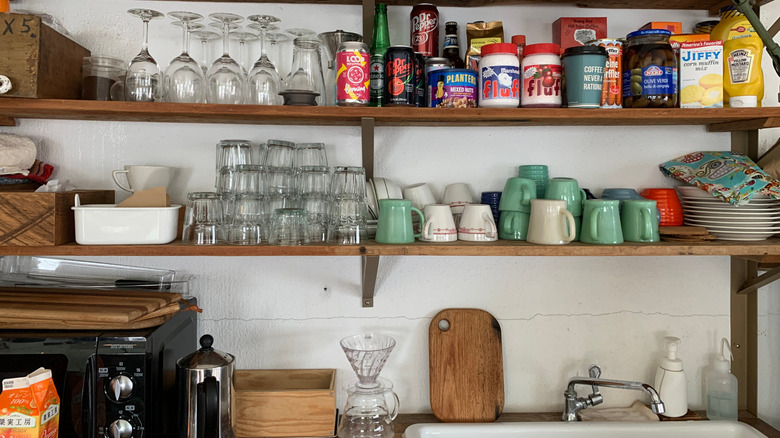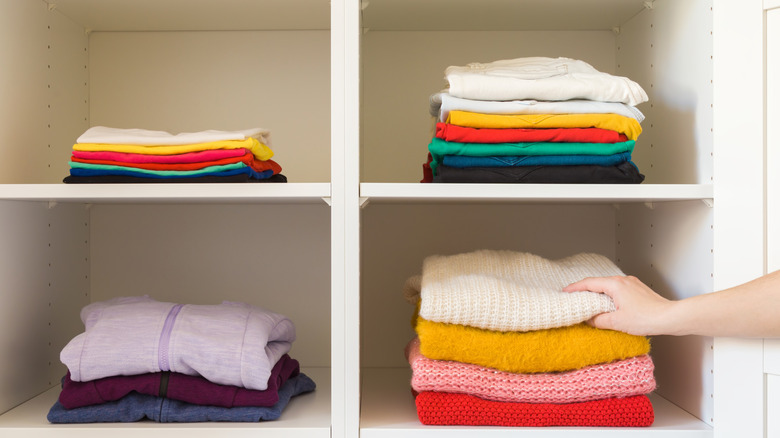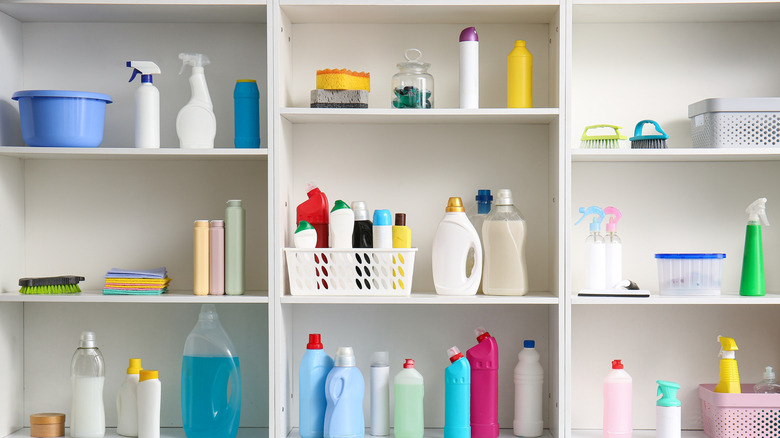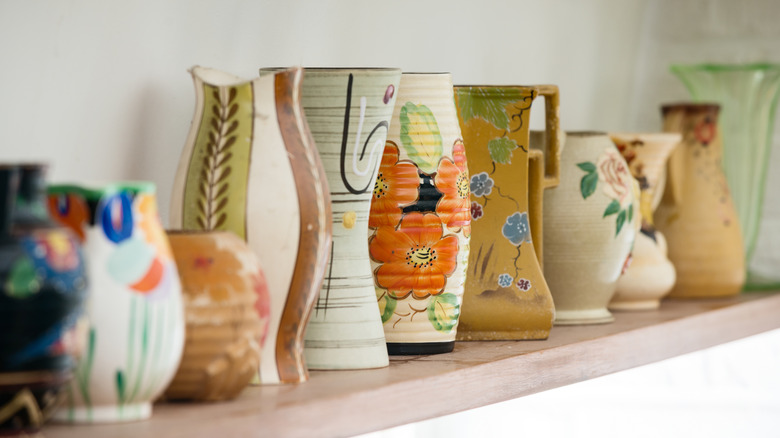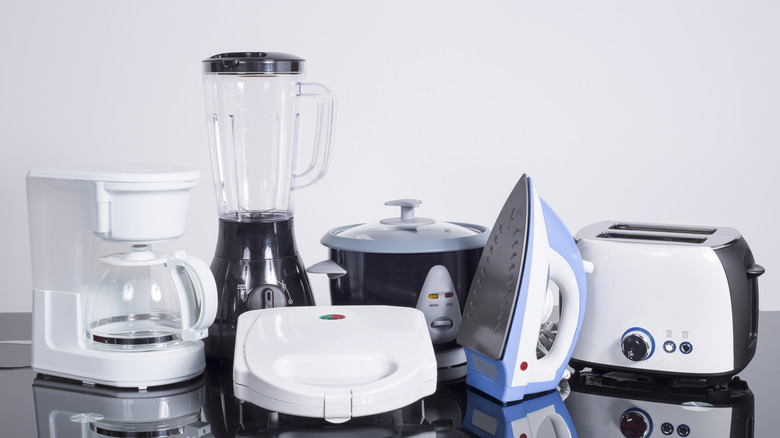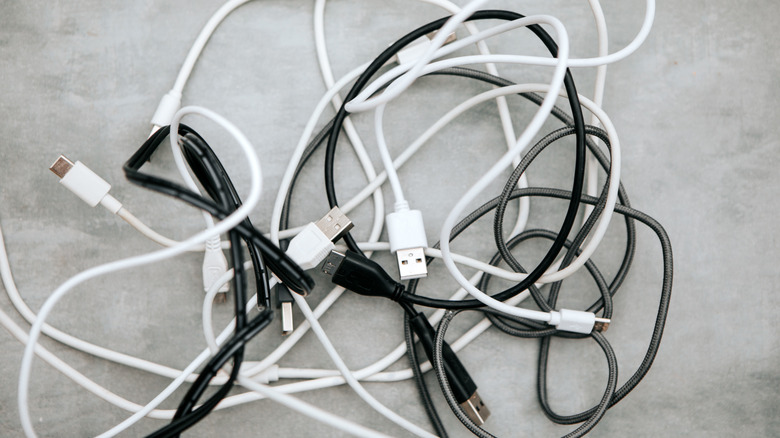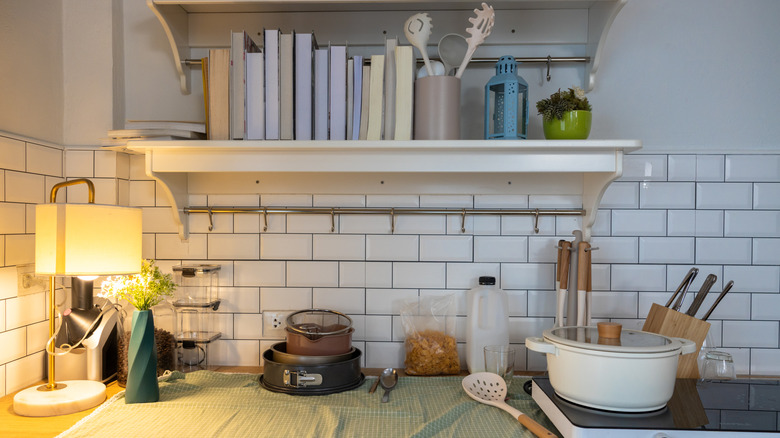8 Things You'll Regret Organizing On Open Shelves (And What To Do Instead)
We may receive a commission on purchases made from links.
Open shelves offer a lot of benefits. Not only can they keep key belongings easily reachable, but they can also enhance your room's decor. There are many ways that you can style open shelving in the kitchen, living room, bedroom, and other rooms of your home. However, there are also things you might regret placing on them. Storing the wrong items can make your space look cluttered or dirty, make dusting a real challenge, or potentially cause damage to some of your belongings.
To learn more about which items are best kept off of them, we reached out to professional organizers and interior designers. They shared their thoughts about which items you'll regret storing on open shelving and offered suggestions on better ways to utilize these fixtures. Find out more by reading through the exclusive quotes they shared with House Digest below.
Keep frequently accessed dishes, clothes, and food items off of open shelves
Storing everything on your open shelves makes things visible and accessible without opening a drawer or a cabinet, so it might be tempting to store items that you use on a regular basis, such as clothing, your everyday dishware, or favorite snacks, on open shelves. However, according to Sara Bereika, a certified professional organizer and the owner of Sara Jane Organizing, you'll likely regret storing these frequently accessed items on an open shelf.
During an exclusive interview with House Digest, Bereika explained, "Maintaining an aesthetically pleasing appearance can be a significant challenge, especially if others in the home are not committed to keeping the system organized. Folded clothes will inevitably topple over or be stuffed away without being properly arranged. Dishes may be placed randomly instead of stacked neatly, and packaged food items can look disheveled and unorganized, making the space a constant eyesore." If you're frequently accessing the items, then that also means that you are frequently returning them to the shelves, which can be where the challenge of keeping everything neat and tidy kicks in.
If you want to use your open shelves to hold regularly accessed snacks and other food items — without running into the problem of everything taking on a cluttered appearance — Angelique Kreller, an interior designer at Yabby, recommends using glass jars or containers to hold these items. In an exclusive interview with House Digest, she said, "They're practical, super chic, and keep everything from pasta to snacks looking cohesive."
Storing utilitarian items on them can make your home look messy
Utilitarian items — or those things that are designed for practicality and functionality, not aesthetics — aren't ideal for your open shelves. "This category includes toiletries, cleaning supplies, tools, pet supplies, office supplies, and similar items. These products do not contribute to an inviting appearance and can appear messy, even when organized neatly on the shelves," explains Bereika.
You don't necessarily have to think twice about adding open shelves to your kitchen. However, you'll want to be more thoughtful about what you organize on them. Instead of using the space to hold utilitarian items, Cara Palmer, the owner of Organize Every Room, recommends reserving open shelves for more decorative items. A few examples that she shared with House Digest include artisanal cutting boards, special occasion serveware, stackable bamboo boxes, or carefully curated collections that you display in groups of three. She also suggests using larger-scale items, as fewer pieces mean that there will be less visual chaos. Additionally, Palmer notes the importance of maintaining a minimum of 30% open space on each shelf to prevent things from looking too cluttered.
When organizing open shelves, Kreller says, "The key is choosing pieces that feel personal and intentional, so the shelves reflect your vibe." She offers a few suggestions to accomplish this goal, such as showcasing some of your favorite books that have attractive covers if you like to read or showcasing some unique or quirky pottery pieces or vases.
Pottery on open shelves can become a dust trap
While showcasing decorative and aesthetically pleasing items on your open shelves is certainly a great way to use the shelves and improve your room's decor, you should be careful about which items you choose to display. Kreller cautions against placing an excessive amount of collectible dishes, vases, and pottery on the shelves. She says, "...glassware or dishes might seem like a cute idea at first, but trust me — they're total dust traps, and it'd be wise to avoid putting them on open shelves." Think about the logistics of trying to keep your shelves clean — and what you'll need to do every time you dust to avoid accidentally breaking one of these prized possessions.
If you're a neat freak and dusting causes you no stress, you may still be worried that your fragile pottery or favorite (but rarely used) stemware could be easily knocked off an open shelf. In this case, consider following Bereika's advice to help them stay in place. She says, "I use museum putty to assist in holding items standing up, like plates or wobbly vases."
Don't overwhelm your open shelves by using them to store small appliances
If you have open shelves in your kitchen, you might be considering using them to store a few small appliances to keep them from taking up so much space on your countertops. However, Maria Anderson, an organization consultant at Henfield Storage, shared some advice against this with House Digest. During an exclusive interview, she said, "Appliances such as toasters, microwaves, and blenders can easily overwhelm open shelves and also make the space look cluttered. Appliances with varied colors can also disrupt the visual appeal of your kitchen."
Instead, consider choosing a clever way to hide your small appliances — such as in an appliance garage or in a slide-out drawer — and use your open shelves for something else. When deciding what to store on open shelves, Bereika notes, "Items should be a manageable size because dusting them becomes quite a chore." Instead, she recommends reserving your open shelves for "books, signature decor pieces, artwork, photographs, and items that coordinate as if they are in the same color family."
Keep paper clutter off of open shelves to avoid a chaotic look
If you have an open shelf right near your entryway or in the kitchen, you might be tempted to put your daily mail, magazine subscriptions, and various notes on it. Christian Pfeiffer, a professional organizer and owner of Valley Organizing, recommends avoiding storing any type of paper clutter on your shelves. He says, "Items like receipts, mail, and loose papers can make open shelves look messy and chaotic."
If the shelf really is the ideal spot to store these items, you don't have to put them directly on the shelf. Instead, Pfeiffer explains, "A better approach would be to replace them with decorative books or bins for a cleaner, more polished look." For example, you could try the DRASTAR mail organizer to keep your bills and letters from giving the shelf a cluttered appearance. As an alternative, Bereika recommends using file holders to keep paper clutter organized. She says, "The file holders make items look less chaotic and provide a more streamlined look. Our eyes need a chance to rest, so if we see everything, we can get overwhelmed."
It's too difficult to keep cables and tech accessories neat enough to store them on open shelves
When you're looking for the best place to keep all those cords, you should probably rethink storing them on open shelves. Even if that open shelf is close to your computer or television, where you're likely to need the cords, you're just asking for trouble trying to store cables and cords like this. "These tend to create visual clutter and can be difficult to keep neat," shares Pfeiffer.
If you really want to store cords and chargers on your open shelves, take Pfeiffer's advice to make sure they don't become an eyesore. He says, "consider concealing them in decorative bins or using wall-mounted cable strips to maintain a tidy appearance." Alternatively, look for something better-suited for storing or displaying on your open shelves and consider a hack to keep your cords and chargers organized. Kreller says, "The secret to open shelving is balance — let your prettiest things steal the spotlight, and give the messier stuff a fun little hiding spot."
Reconsider storing cookbooks on open shelves if they will be exposed to steam
You might think that the open shelves near your stovetop are the ideal spot to keep your cookbooks. When you're ready to prepare a recipe, the cookbook you need will be in a convenient spot and quick to grab. However, Palmer shares one reason you may end up regretting storing your cookbooks — or any other books — on an open shelf. "While they look gorgeous in staged photos, they often warp from temperature fluctuations near windows and kitchen humidity. I've seen entire cookbook collections ruined by subtle water damage from cooking steam," she explains.
If you want to keep books on an open shelf, make sure that they are away from the stovetop or any other part of the room where they will be exposed to fluctuating temperatures. You might want to consider placing your cookbooks inside a kitchen cabinet and storing something else on your open shelf. Non-porous objects, like a favorite recipe tucked away into a metal frame, are great for this spot because they can easily be removed, wiped clean, and replaced.
